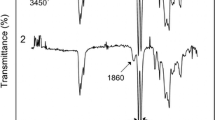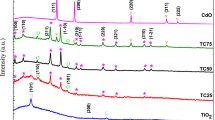Abstract
The successive ionic layer adsorption and reaction (SILAR) method has been used to grow epitaxial CdS–polymer nanostructures as thin films with different surface morphology and particle size. The main purpose of the study was to investigate the dielectric properties and a.c. electrical conductivity (σ a.c.), by a.c. impedance spectroscopy between 1 kHz and 1 MHz, at room temperature, of CdS–polymer nanocomposites produced by use of 2, 6, and 10 cycles of SILAR. The surface morphology and optical absorption of the samples were characterized by scanning electron microscopy (SEM) and UV–visible spectroscopy, respectively. Determination of the energy gaps of CdS–polymer nanocomposites prepared by use of different numbers of cycles of SILAR reveals that the band gap decreases with increasing number of cycles (J. Cryst. Growth 305, 175–180, 2007). This behavior is because of the growth of nanoparticles in the matrix materials, and can be explained by changes in the amount of confinement as a consequence of particle size variation. SEM images also confirm that different numbers of cycles lead to different morphology. Frequency-dependent dielectric properties and a.c. electrical conductivity of the samples prepared by use of different numbers of cycles of SILAR were investigated, and comparative studies on some electrophysical properties of the samples are reported. Experimental results show that values of the dielectric constant (ε′), dielectric loss (ε″), dielectric loss tangent (tanδ), the real (M′) and imaginary (M″) parts of electric modulus, and σ a.c. are highly dependent on the frequency and the number of cycles. It can be concluded that changing the frequency and the number of cycles substantially alters both the dielectric properties and a.c. electrical conductivity of the samples.
Similar content being viewed by others
References
Y. Azizian kalandaragh, M.B. Muradov, R.K. Mammedov, and A. Khodayari, J. Cryst. Growth 305, 175–180 (2007).
P.K. Khanna and Narendra Singh, J. Lumin. 127, 474–482 (2007).
A. Dey, S. De, A. De, and S.K. De, Nanotechnology 15, 1277–1283 (2004).
H. Geng, Y. Guo, R. Peng, Sh Han, and M. Wang, Sol. Energy Mater. Sol. Cells 94, 1293–1299 (2010).
H. Yang, O.A. Ileperuma, M. Shimomura, and K. Murakami, Sol. Energy Mater. Sol. Cells 93, 1083–1086 (2009).
W. Cai, X. Gong, and Y. Cao, Sol. Energy Mater. Sol. Cells 94, 114–127 (2010).
W.U. Huynh, X. Peng, and A.P. Alivisatos, Adv. Mater. 11, 932 (1999).
J.M. Lee, C.P. Judge, and S.W. Wright, Solid State Electron. 44, 1431–1434 (2000).
M. Jørgensen, K. Norrman, and F.C. Krebs, Sol. Energy Mater. Sol. Cells 92, 686–714 (2008).
Y. Azizian-Kalandaragh and A. Khodayari, Mat. Sci. Sem. Proc. 13, 225–230 (2010).
D. Rezaei-Ochbelagh, Y. Azizian-Kalandaragh, and A. Khodayari, Optoelect. Adv. Mater-RC 4, 881–883 (2010).
Y. Azizian-Kalandaragh, Optoelect. Adv. Mater-RC 4, 1655–1658 (2010).
Y. Azizian-Kalandaragh, Optoelect. Adv. Mater-RC 4, 174–179 (2010).
P.K. Ghosh, S. Jana, U.N. Maity, and K.K. Chattopadhyay, Physica E 35, 178–182 (2006).
J.S. Jie, W.J. Zhang, Y. Jiang, X.M. Meng, Y.Q. Li, and S.T. Lee, Nano Lett. 6, 1887–1892 (2006).
L. Wang, Y. Liu, X. Jiang, D. Qin, Y. Cao, and J. Phys, Chem. C 111, 9538–9542 (2007).
X. Jiang, F. Chen, H. Xu, L. Yang, W. Qiu, M. Shi, M. Wang, and H. Chen, Sol. Energy Mater. Sol. Cells 94, 338–344 (2010).
G.L. Tan, Y. Chen, and X.F. Yu, Nanotechnology 21, 035701 (2010).
K. Susumu, H.T. Uyeda, I.L. Medintz, T. Pons, J.B. Delehanty, and H. Mattoussi, J. Am. Chem. Soc. 129, 13987–13996 (2007).
A. Boulesbaa, A. Issac, D. Stockwell, Z. Huang, J. Huang, and J. Guo, et al., J. Am. Chem. Soc. 129, 15132–15133 (2007).
T. Cui, J. Zhang, J. Wang, F. Cui, W. Chen, and F. Xu, et al., Adv. Funct. Mater. 15, 481–486 (2005).
P.S. Chowdhury, P. Ghosh, and A. Patra, J. Lumin. 124, 327–332 (2007).
J.R. Lakowicz, I. Gryczynski, G. Piszczek, and C.J. Murphy, J Phys Chem B 106, 5365–5370 (2002).
C. Burda, X. Chen, R. Narayanan, and M.A. El-Sayed, Chem. Rev. 105, 1025–1102 (2005).
S. Kuchibhatla, A.S. Karakoti, D. Bera, and S. Seal, Prog. Mater Sci. 52, 699–913 (2007).
A. Eychmuller, J. Phys. Chem. B 104, 6514–6528 (2000).
D. Tasis, N. Tagmatarchis, A. Bianco, and M. Prato, Chem. Rev. 106, 1105–1136 (2006).
M. Mumtaz and N.A. Khan, Physica C 469, 728 (2009).
N.A. Kahn, M. Mumtaz, and A.A. Khurram, J. Appl. Phys. 104, 033916 (2008).
L.L. Hench and J.L. West, Principles of Electronic Ceramics (New York: Wiley, 1990).
I.M. Afandiyeva, I. Dökme, Ş. Altındal, M.M. Bülbül, and A. Tataroğlu, Microelectron. Eng. 85, 247 (2008).
V.V. Klechkovskaya, V.N. Maslov, M.B. Muradov, and S. Semiletov, Sov. Phys. Crystallogr. 34, 105 (1989).
V.V. Klechkovskaya, V.N. Maslov, M.B. Muradov, and S. Semiletov, Izv. Akad. Nauk SSSR. Ser. Fiz 52, 1324 (1988).
V.P. Tolstoi, Russ. Chem. Rev. (English Translation) 62, 237 (1993).
S. Lindroos, T. Kanniainen, and M. Leskela, Appl. Surf. Sci. 75, 70 (1994).
S. Lindroos, T. Kanniainen, and M. Leskela, Thin Solid Films 263, 79 (1995).
Y.F. Nicolau and J.C. Minnard, J. Crystal Growth 92, 128 (1988).
Y. Wang and N. Herron, J. Phys. Chem. 95, 525–532 (1991).
F. Kremer, A. Schonhals, and W. Luck, Broadband Dielectric Spectroscopy (Berlin: Springer, 2002).
H.M. Pathan and C.D. Lokhande, Indian Acad. Sci. 27, 85 (2003).
M. Popescu and I. Bunget, Physics of Solid Dielectrics (Amsterdam: Elsevier, 1984).
N.G. McCrum, B.E. Read, and G. Williams, Anelastic and Dielectric Effects in Polymeric Solids (London: Wiley, 1967).
P. Pissis and A. Kyritsis, Solid State Ionics 97, 105 (1997).
A.A. Sattar and S.A. Rahman, Phys. Status Solid 200, 415 (2003).
S. Altındal, H. Yeriskin, İbrahım Unal, and B. Sarı, J. Appl. Polym. Sci. 120, 390 (2011).
G.C. Psarras, E. Manolakaki, and G.M. Tsangaris, Compos. Part A 34, 1187 (2003).
Author information
Authors and Affiliations
Corresponding author
Rights and permissions
About this article
Cite this article
Azizian-Kalandaragh, Y., Aydemir, U. & Altindal, Ş. Dielectric and Optical Properties of CdS–Polymer Nanocomposites Prepared by the Successive Ionic Layer Adsorption and Reaction (SILAR) Method. J. Electron. Mater. 43, 1226–1231 (2014). https://doi.org/10.1007/s11664-014-2998-4
Received:
Accepted:
Published:
Issue Date:
DOI: https://doi.org/10.1007/s11664-014-2998-4




